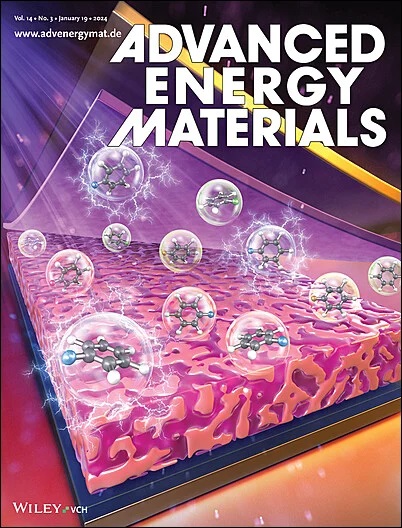全面了解立体阻碍对锌离子转移和还原动力学之间权衡的影响,实现高度可逆和稳定的锌阳极
IF 24.4
1区 材料科学
Q1 CHEMISTRY, PHYSICAL
引用次数: 0
摘要
缓慢的传质过程与快速的电化学还原动力学之间的矛盾所导致的电极界面浓度极化极大地限制了锌阳极的实际应用。创造一种适度的锌离子转移和还原化学反应对于锌离子电池的耐用性至关重要。在这项工作中,通过选择大尺寸的 4-Aminomethyl cyclohexanecarboxylic acid(AMCA)分子作为电解质添加剂,实现了这种权衡效应。耐人寻味的是,AMCA 分子通过与 Zn2+ 的牢固配位重组了 Zn2+ 的溶解结构,并重建了 H 键网络,从而实现了拉动式解溶解过程。同时,AMCA 以推力扩大了 Zn2+ 的溶胶尺寸,限制了快速电化学还原动力学。通过适度的拉推相互作用,平衡的化学环境得以维持。此外,AMCA 还能锚定在锌表面,创造一个贫水的微环境,促进锌(002)的均匀沉积,并有效限制水引起的副反应。值得注意的是,带有 AMCA 的 Zn||Zn 对称电池在 20 mA cm-2 的条件下可稳定运行 167 天。此外,采用 AMCA 的 Zn||VOX 全电池在 2 A g-1 的条件下循环 590 次后仍能确保 99.15% 的出色容量保持率,即使在低 N/P(4.3)、贫电解质(50 µL mAh-1)和 10 µm 超薄锌箔的条件下也是如此。这项研究为高性能锌电池的平衡界面化学设计提供了独特的见解。本文章由计算机程序翻译,如有差异,请以英文原文为准。

Comprehensive Understanding of Steric-Hindrance Effect on the Trade-Off Between Zinc Ions Transfer and Reduction Kinetics to Enable Highly Reversible and Stable Zn Anodes
The electrode interface concentration polarization attributed to the contradiction between sluggish mass transfer process and rapid electrochemical reduction kinetics significantly restricts the practical application of Zn anode. Creating a moderate Zn ions transfer and reduction chemistry is essential for durable zinc-ion batteries. In this work, this trade-off effect is realized by selecting large-size 4-Aminomethyl cyclohexanecarboxylic acid (AMCA) molecule as the electrolyte additive. Intriguingly, AMCA molecules reorganize the Zn2+ solvation structure via the robust coordination with Zn2+ and reconstruct H-bond networks, giving a pulled desolvation process. Meanwhile, AMCA enlarges the Zn2+ solvation size with a push force, confining the rapid electrochemical reduction kinetics. The balanced chemical environment is maintained via the moderate pull-push interplay. Besides, AMCA can anchor on zinc surface to create a water-poor microenvironment, fostering homogeneous Zn (002) deposition and effectively restricting water-induced side-reactions. Notably, the Zn||Zn symmetric cell with AMCA operates stably over 167 days at 20 mA cm−2. Moreover, the Zn||VOX full cell employed AMCA ensures outstanding capacity retention of 99.15% after 590 cycles at 2 A g−1, even with low N/P (4.3), lean electrolyte (50 µL mAh−1) and ultrathin Zn foil of 10 µm. This work reveals unique insights into the balanced interfacial chemistry design toward high-performance zinc batteries.
求助全文
通过发布文献求助,成功后即可免费获取论文全文。
去求助
来源期刊

Advanced Energy Materials
CHEMISTRY, PHYSICAL-ENERGY & FUELS
CiteScore
41.90
自引率
4.00%
发文量
889
审稿时长
1.4 months
期刊介绍:
Established in 2011, Advanced Energy Materials is an international, interdisciplinary, English-language journal that focuses on materials used in energy harvesting, conversion, and storage. It is regarded as a top-quality journal alongside Advanced Materials, Advanced Functional Materials, and Small.
With a 2022 Impact Factor of 27.8, Advanced Energy Materials is considered a prime source for the best energy-related research. The journal covers a wide range of topics in energy-related research, including organic and inorganic photovoltaics, batteries and supercapacitors, fuel cells, hydrogen generation and storage, thermoelectrics, water splitting and photocatalysis, solar fuels and thermosolar power, magnetocalorics, and piezoelectronics.
The readership of Advanced Energy Materials includes materials scientists, chemists, physicists, and engineers in both academia and industry. The journal is indexed in various databases and collections, such as Advanced Technologies & Aerospace Database, FIZ Karlsruhe, INSPEC (IET), Science Citation Index Expanded, Technology Collection, and Web of Science, among others.
 求助内容:
求助内容: 应助结果提醒方式:
应助结果提醒方式:


